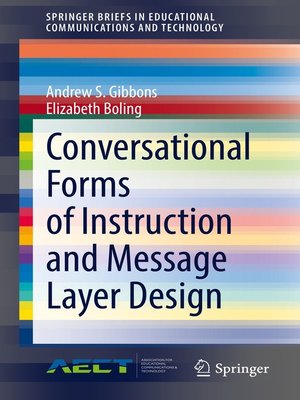Conversational Forms of Instruction and Message Layer Design
ebook ∣ SpringerBriefs in Educational Communications and Technology
By Andrew S. Gibbons

Sign up to save your library
With an OverDrive account, you can save your favorite libraries for at-a-glance information about availability. Find out more about OverDrive accounts.
Find this title in Libby, the library reading app by OverDrive.



Search for a digital library with this title
Title found at these libraries:
| Library Name | Distance |
|---|---|
| Loading... |
This book examines the theoretical basis of one of the functional layers—the message layer—of an architectural theory of instructional design. The architectural theory (Gibbons, 2003; Gibbons & Rogers, 2009; Gibbons, 2014) identifies seven functions carried out during instruction that correspond with designable strata, or layers.
The architectural theory proposes that for each layer there exists a specialized body of design languages, constructs, questions, tools, practices, processes, a professional community, and most especially, bodies of design theory. It also proposes that design knowledge from other design fields, many of which approach design from the same functional perspective, can be appropriated for the further development of knowledge within the instructional technology field.
A robust literature from disparate fields supplies relevant theory for message layer design. This book builds the case for validationof the message layer by bringing together work from instructional theory, conversation theory, research in the learning sciences, intelligent tutoring system research, and K-12 education. Within this literature, the authors demonstrate the existence of the message as a structural abstraction: an independently designable entity. They trace the development of the message construct historically, showing that it has remained remarkably stable over time, independent of changing psychological, educational, and technological conventions.
The architectural theory proposes that for each layer there exists a specialized body of design languages, constructs, questions, tools, practices, processes, a professional community, and most especially, bodies of design theory. It also proposes that design knowledge from other design fields, many of which approach design from the same functional perspective, can be appropriated for the further development of knowledge within the instructional technology field.
A robust literature from disparate fields supplies relevant theory for message layer design. This book builds the case for validationof the message layer by bringing together work from instructional theory, conversation theory, research in the learning sciences, intelligent tutoring system research, and K-12 education. Within this literature, the authors demonstrate the existence of the message as a structural abstraction: an independently designable entity. They trace the development of the message construct historically, showing that it has remained remarkably stable over time, independent of changing psychological, educational, and technological conventions.







